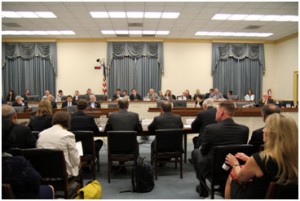
A new article in The Huffington Post starts with the question, “Whatever happened to innovation in America?” and concludes by hinting that American innovation is not what it once was. According to studies cited by the authors, the United States is second to last in terms of progress over the past decade.
So, who are the global leaders?
By one measure, global leaders include countries like Sweden and Finland, which are also some of the most progressive countries in the world when it comes to taking action on hazardous chemicals. It’s no accident that Sweden, Norway, and other progressive countries in Europe are ahead of the United States in innovation according to several estimates. The EU has been leading the world in developing more rigorous laws to eliminate hazardous chemical exposure, and these laws drive innovation in the EU (and around the world). As I described in my recent blog, the United States has been unable to similar take action because of a deeply flawed law that has not been reformed in over 30 years: the Toxic Substances Control Act (TSCA). The problems with TSCA must be dealt with in order to address lagging American innovation efforts.
Nota bly absent in the recent hearing examining TSCA and its role in innovation was any mention of how the United States compares with other countries when it comes to the type of innovation we want. We need innovation that creates not only more functional products, but also products that are healthier for people and wildlife and take less of a toll on the environment.
bly absent in the recent hearing examining TSCA and its role in innovation was any mention of how the United States compares with other countries when it comes to the type of innovation we want. We need innovation that creates not only more functional products, but also products that are healthier for people and wildlife and take less of a toll on the environment.
At the briefing, CIEL’s recent report, Driving Innovation, was cited by witness Heather White. In addition, a letter that CIEL submitted for the hearing was also quoted and entered into the record by champion for chemical policy reform Representative Waxman (D-CA33).
For the innovation of safer chemicals, they must enter the market. To do so, they must overcome barriers to entry that benefit the status quo mix of chemicals on the market. The hearing did not emphasize this issue despite the fact that government regulation is crucial to help safer alternatives overcome barriers to entry to be able to compete with existing chemicals that already enjoy the economy of scale.
Many of the expert witnesses testified that what works well (for their industries) within the current chemical system are the scarcity of hurdles that new chemicals must clear before entering the marketplace – many of which eventually enter our homes and bodies. Ninety percent (90 %) of applications to manufacture new chemicals are approved without any determination as to whether or not they are likely to meet a meaningful safety standard. With such low standards for reporting a chemical’s safety, chemicals advertised as safe alternatives pass EPA review only to be discovered later that they pose a threat to environmental and human health. To avoid these cases of regrettable substitution, a minimum data set should be required for all chemicals. The EU’s REACH regulation takes this approach for all chemicals where production exceeds 1 ton per year. Although witnesses repeatedly testified about the benefit of TSCA’s “tailored” approach, this approach allows industry to avoid submitting all relevant information about a chemical’s safety. In contrast, the EU’s regulation is tailored to chemicals; as production volume and evidence of adverse effects increase, so do information disclosure requirements placed on industry. REACH uses a hazard-based approach where scientific evidence of hazard provided by industry is used to fill the data gap on exposure impacts. This encourages market substitutions away from carcinogens, endocrine disruptors, and other toxic chemicals in a systematic fashion. Without the requirement to submit sufficient information, there is little incentive to focus innovations on safer alternative chemicals.
With such low standards for reporting a chemical’s safety, chemicals advertised as safe alternatives pass EPA review only to be discovered later that they pose a threat to environmental and human health. To avoid these cases of regrettable substitution, a minimum data set should be required for all chemicals. The EU’s REACH regulation takes this approach for all chemicals where production exceeds 1 ton per year. Although witnesses repeatedly testified about the benefit of TSCA’s “tailored” approach, this approach allows industry to avoid submitting all relevant information about a chemical’s safety. In contrast, the EU’s regulation is tailored to chemicals; as production volume and evidence of adverse effects increase, so do information disclosure requirements placed on industry. REACH uses a hazard-based approach where scientific evidence of hazard provided by industry is used to fill the data gap on exposure impacts. This encourages market substitutions away from carcinogens, endocrine disruptors, and other toxic chemicals in a systematic fashion. Without the requirement to submit sufficient information, there is little incentive to focus innovations on safer alternative chemicals.
In discussions on confidential business information (CBI), the fact that information drives innovation was missing. CBI never expires, meaning that chemical mixtures and their properties remain confidential for their entire market lifetime. Although industry hopes to preserve CBI, secrecy hinders the ability of innovators to identify areas for improvement and to create safer chemicals and formulations. Access to information on chemical hazards will not only allow others to identify regrettable substitutes before they are made available on the market, but also incentivize the development and adoption of safer alternatives. As safer alternatives are increasingly adopted and used, they will enjoy the economies of scale that now favor entrenched hazardous chemicals. It is crucial that all chemicals have basic health and safety information in the public domain to move towards an environment in which our food, water, consumer products and homes are free of toxic-chemicals. The release of certain information about chemicals (at least after a certain timeframe) and confirming the legitimacy of CBI claims will encourage innovation toward safer alternatives.
The above points must be considered to ensure a well-rounded dialogue on chemical regulation reform. This reform will allow the US to regain its position of leadership at the global level, both as a leader in innovation and in setting the highest standards when it comes to chemicals law and policy. Regulation does not impede the innovation of safer chemicals; rather, stronger laws enable the entry of safer chemical innovations into the market.
Originally posted on October 7, 2013.
